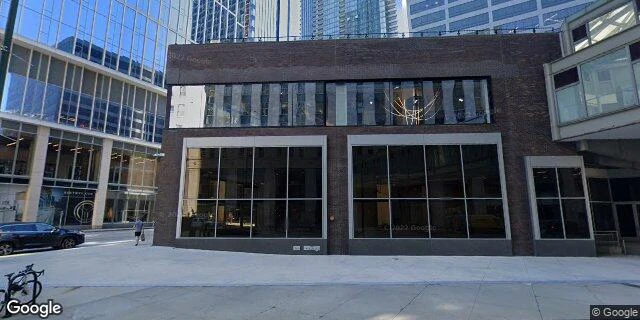River North Point
🚩
Chicago Building ID: 103653

Attribution: © Google 2025
Building Info
- Square Footage
- 1,883,966 sqft#27 Largest#12 Largest of Offices13x median139,707 sqft7x median Office259,000 sqft
- Built
- 1975
- Primary Property Type
- Office
- Community Area
- Near North Side
- Ward
- 42
-
Chicago Energy Rating
- 2.5 / 4
-
Energy Star Score
- 60 / 100
- Owner
2022 Report Card
Debug Full Grade Data
- AvgPercentileLetterGrade: C
- AvgPercentileGrade: 59.304781752169454
- GHGIntensityLetterGrade: D
- GHGIntensityPercentileGrade: 22.70588235294117
- EnergyMixLetterGrade: A
- EnergyMixWeightedPctSum: 96.99552152913584
- EnergyMixPercentileGrade: 94.87960143924715
- SubmittedRecordsLetterGrade: A
- MissingRecordsCount: 0.0
- SubmittedRecordsPercentileGrade: 100.0
Emissions & Energy Information for 2022
- Greenhouse Gas Intensity D
- 8.3 kg CO2e / sqftHigher than 77% of all buildings1.3x median6.4 kg CO2e / sqft1.2x median Office6.9 kg CO2e / sqft
- Total Greenhouse Gas Emissions
- 15,658 tons CO2e#28 Highest in Chicago* 🚩#8 Highest of Offices 🚨18x median885.8 tons CO2e9x median Office1,832.2 tons CO2e
Years Reported
9/9
A

2014
2015
2016
2017
2018
2019
2020
2021
2022
Energy Breakdown
- Fossil Gas Use (aka Natural Gas)
- 4,139,006 kBtuEst. Gas Bill: $49,000 for 2022**Lower than 63% of all buildings0.7x median5,818,399.6 kBtu1.5x median Office2,672,800.1 kBtu
- Electricity Use
- 106,274,498 kBtuEst. Electric Bill: $4,454,000 for 2022**#22 Highest in Chicago* 🚩#8 Highest of Offices 🚨28x median3,796,376.7 kBtu10x median Office10,340,763.6 kBtu
- District Chilled Water Use
- 27,347,734 kBtu
Most buildings don't use district chilling, so we don't currently have comparison data.
Energy Mix A
Total Energy Use: 137,761,240 kBTU
View Extra Technical & Historic Info
- Source Energy Usage Intensity
- Not Reported
This data was not reported for this building this year, which likely means a value of zero for this field.
- Site Energy Usage Intensity
- Not Reported
This data was not reported for this building this year, which likely means a value of zero for this field.
Full Historical Data Table for River North Point
| Year |
Overall Grade |
Emissions Intensity Sub-Grade |
Energy Mix Sub-Grade |
Reporting Mix Sub-Grade | GHG Intensity kg CO2e / sqft | GHG Emissions metric tons CO2e | Energy Mix | Electricity Use kBTU | Fossil Gas Use kBTU |
District Steam Use kBTU |
District Chilled Water Use kBTU | Source EUI kBTU / sqft | Floor Area sqft |
Chicago Energy Rating |
Energy Star Score |
|---|---|---|---|---|---|---|---|---|---|---|---|---|---|---|---|
| 2014 | C | F | B | A | 19.25 | 33,470 | 79%Electricity 2%Fossil Gas 19%Other | 155,920,041 | 3,700,700 | - | 36,941,830 | 305 | 1,738,520 | - | 72.0 |
| 2015 | C | F | A | A | 19.4 | 33,754 | 77%Electricity 2%Fossil Gas 21%Other | 155,971,084 | 4,440,173 | - | 41,393,830 | 308.2 | 1,738,520 | - | 69.0 |
| 2016 | C | F | A | A | 15.4 | 29,056 | 75%Electricity 2%Fossil Gas 22%Other | 144,127,043 | 4,706,927 | - | 42,512,412 | 265.4 | 1,883,966 | - | 49.0 |
| 2017 | C | F | A | A | 14.9 | 28,090 | 76%Electricity 2%Fossil Gas 22%Other | 139,274,428 | 4,152,515 | - | 40,208,089 | 255.8 | 1,883,966 | - | 51.0 |
| 2018 | C | F | A | A | 14.4 | 27,128 | 76%Electricity 2%Fossil Gas 22%Other | 148,300,669 | 3,607,885 | - | 42,967,513 | 243.2 | 1,883,966 | 1.5 | 31.0 |
| 2019 | C | F | A | A | 14 | 26,395 | 78%Electricity 1%Fossil Gas 21%Other | 145,697,825 | 2,437,000 | - | 38,456,400 | 236.5 | 1,883,966 | 2.0 | 41.0 |
| 2020 | C | F | A | A | 10.2 | 19,305 | 77%Electricity 0%Fossil Gas 23%Other | 112,089,931 | 716,600 | - | 33,646,499 | 183.2 | 1,883,966 | 3.5 | 57.0 |
| 2021 | B | D | A | A | 8 | 15,073 | 77%Electricity 0%Fossil Gas 23%Other | 94,963,774 | 3,860 | - | 28,655,408 | 155 | 1,883,966 | 4.0 | 67.0 |
| 2022 | C | D | A | A | 8.3 | 15,658 | 77%Electricity 3%Fossil Gas 20%Other | 106,274,498 | 4,139,007 | - | 27,347,735 | 173.5 | 1,883,966 | 2.5 | 60.0 |
* Note on Rankings: Rankings and medians are among included buildings, which are those who reported under the Chicago Energy Benchmarking Ordinance for the year 2022, which only applies to buildings over 50,000 square feet.
** Note on Bill Estimates:
Estimates for gas and electric bills are based on average electric and
gas retail prices for Chicago in 2021 and
are rounded. We expect large buildings would negotiate lower rates with
utilities, but these estimates serve as an upper bound of cost and help
understand the volume of energy a building is used by comparing it to
your own energy bills! See our
Chicago Gas & Electric Costs Source
for the original statistics.
Data Source:
Chicago Energy Benchmarking Data